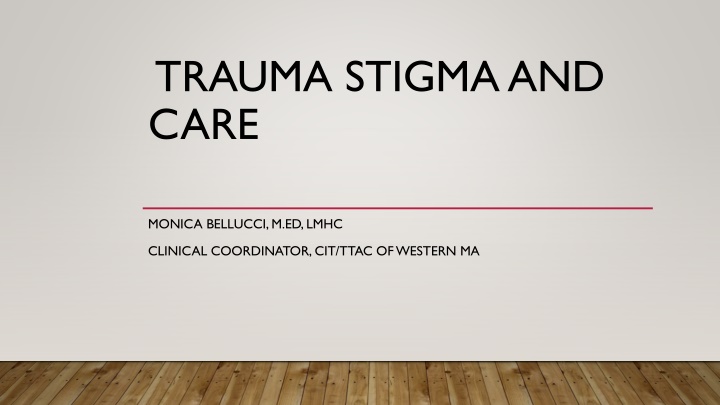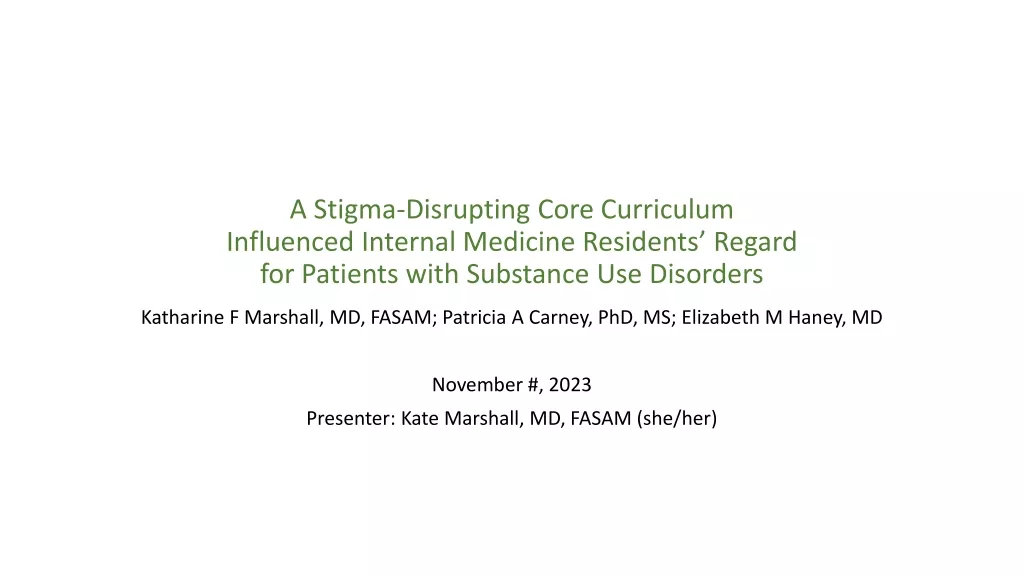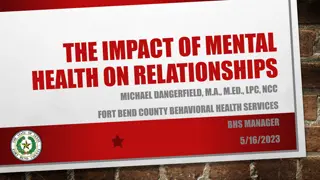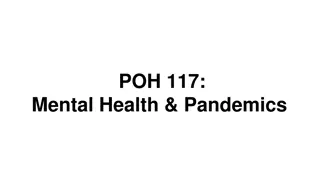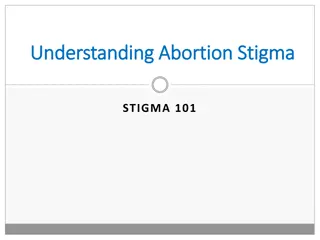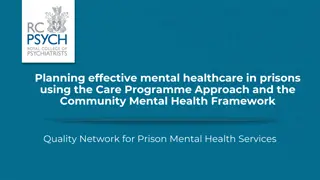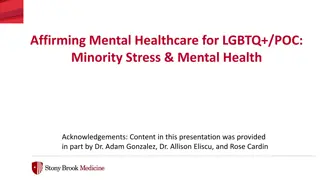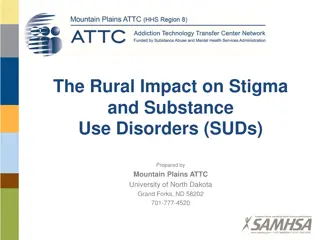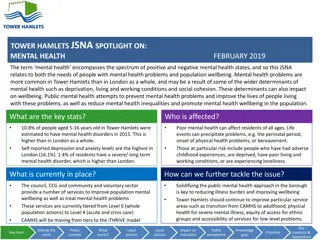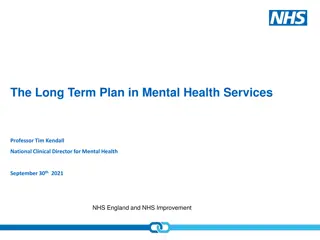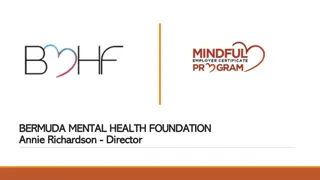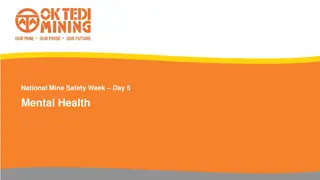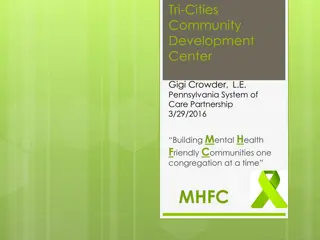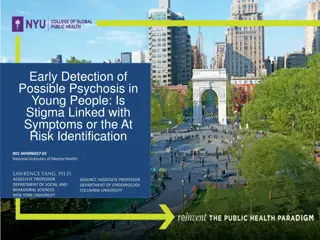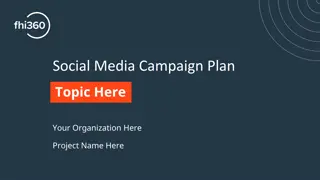Stigma and Mental Health
Examine the impact of stigma on individuals with mental illness, explore barriers to treatment, and learn practical approaches to support those in crisis. Discover facts and experiences of those affected, debunk myths, and promote understanding and empathy.
Download Presentation

Please find below an Image/Link to download the presentation.
The content on the website is provided AS IS for your information and personal use only. It may not be sold, licensed, or shared on other websites without obtaining consent from the author.If you encounter any issues during the download, it is possible that the publisher has removed the file from their server.
You are allowed to download the files provided on this website for personal or commercial use, subject to the condition that they are used lawfully. All files are the property of their respective owners.
The content on the website is provided AS IS for your information and personal use only. It may not be sold, licensed, or shared on other websites without obtaining consent from the author.
E N D
Presentation Transcript
TRAUMA STIGMA AND CARE MONICA BELLUCCI, M.ED, LMHC CLINICAL COORDINATOR, CIT/TTAC OF WESTERN MA
LEARNING OBJECTIVES Participants will be able to identify to identify stigma and how it affects those living with mental illness Participants will be able to identify how the brain operates under prolonged stress Participants will be able to identify trauma response and what they look like Participants will be able to identify practical approaches to utilize when experiencing someone in a mental health crisis.
ACTIVITY What are some ways we speak to those with mental illness? Green post-its What are some ways speak about those struggling with cancer pink post-its
WHAT IS STIGMA 1. Public Perception: Stigmatizing attitudes often lead to misconceptions about mental health conditions, viewing them as personal weaknesses or character flaws rather than legitimate medical conditions. 2. Labeling: People with mental health conditions may be unfairly labeled or defined solely by their condition, reducing their identity and potential to the challenges they face. 3. Social Isolation: Stigma can result in social isolation, as individuals with mental health conditions may be avoided or excluded due to fear or misunderstanding. 4. Discrimination: Stigmatization can lead to discriminatory behavior in various aspects of life, including employment, education, housing, and relationships. 5. Self-Stigma: People who experience mental health conditions may internalize the negative stereotypes and beliefs, leading to reduced self-esteem and reluctance to seek help. 6. Barriers to Treatment: Stigma can discourage individuals from seeking professional help or treatment, leading to delayed or inadequate care, which can worsen their condition.
SOME FACTS AND EXPERIENCES OF THOSE WITH MENTAL ILLNESS Around 60% of adults with a mental health illness don t receive care NAMI It takes on average 11 years from the start of a mental health symptoms to when someone receives treatment Approximately 68% of women and 57% of men with mental health problems are parents. The most common mental health problems experienced during pregnancy and after birth are anxiety, depression and post-traumatic stress disorder (PTSD). (Mental Health Foundation) Nearly 50% of all mental illnesses begin in childhood before the age of 14 years, (national institute of health) More than one in five U.S. adults live with a mental illness (57.8 million in 2021).(NAMI)
STIGMA Myth: People with mental health conditions are more violent. Only 3% 5% of violent acts can be attributed to individuals living with a serious mental illness. In fact, people with severe mental illnesses are over 10 times more likely to be victims of a violent crime than the general population
STIGMA People living with mental illness are more likely to encounter the criminal justice system, resulting in a large number of arrests and incarcerations. The overall annual cost of incarcerating people with serious mental illness in state prisons in Massachusetts reaches exceeds $250 million.
TRAUMA INFORMED POLICING What is wrong with you To What happened to you
LETS TALK ABOUT TRAUMA What is trauma The lasting emotional response that results from living through a distressing event The effect on your brain s emotional networks to make you over or under react to situations Anything which has overloaded out neuro and physical system which we haven t been able to fully process and or metabolize.
TYPES OF TRAUMA Single event/Acute trauma Car accident House fires Mugging Sexual assault Chronic Trauma/on-going War combat Domestic Violence Sexual Abuse Bullying Complex Trauma/multiple on-going generally in the context of interpersonal relationships
SOME KEY FACTORS TO REMEMBER What is traumatic isn t always dramatic Trauma is stored in the emotional center of our brain and in our bodies. Trauma is not stored in our language and rational/cognition part of our brain Trauma is not stored in a linear fashion
REPTILIAN BRAIN Brain stem and cerebellum. It operates on instinct and is responsible for the survival-related functions of the of the body. The reptilian brain is most closely associated with body processing. Instinctive trauma responses, such as fight, flight, freeze, or startle responses, and crying for help are all examples of reptilian brain functions. The reptilian brain also controls the autonomic responses that we experience as body sensations and basic life-sustaining processes, like digestion, heart rate, body temperature, and respiration.
THE MAMMALIAN BRAIN EMOTIONAL BRAIN The mammalian brain includes the thalamus, amygdala, and hippocampus. This is the emotional or limbic brain, is responsible for our emotional and relational experiences. Emotions lend another dimension to our experience by letting us know of our likes and dislikes relationships, it s responsible for us feeling drawn towards or away from things and for holding emotional memories of our experiences. These experiences of shared pleasure or pain are also encoded as nonverbal memories of attachment experiences, laying down templates for expectations of future relationships.
THE NEOCORTEX HUMAN BRAIN The cerebral cortex, the frontal cortex, is the front structure of our brain. It contains most of our language/communication abilities. This hemisphere of the brain processes information in an explicit, direct, logical, analytical, and linear fashion. It s important for our functioning in a health lifestyle, that everything is integrated and linked. This is the part of the brain that is offline when someone is experiencing a trauma response. This part of the brain is not fully developed until around age 25. This is the youngest part of our brain both on an individual basis and an evolution basis
TRAUMA RESPONSES Involuntary responses, reactions or behaviors, that one may engage in during times of high and or chronic/toxic stress. These involuntary responses can be from real or perceived threats. Fight aggression Flight running, avoiding Freeze numbing, shutting down Appease overly compliant What are some experiences law enforcement may have experienced in each of these responses
REVIEW Does stigma affect trauma? What are some barriers to treatment? What happens to our human Brain or our language logical executive functioning during a trauma response? At what age does our brain fully develop and what is the last part of our brain to develop? What are the four types of Trauma responses and what do they look like?
REVIEW During a trauma response what two parts of the brain are being are we working with ? During a trauma response what part of the brain should we not be trying to solely work with? What are some things we should do during a trauma response to help the reptile brain? What are some things we should do during a trauma response to help the mammal brain? What are some things we should do during a trauma response to help the human brain?
